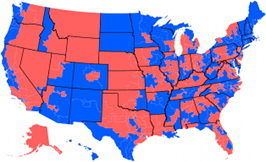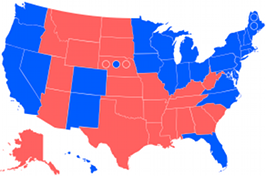It’s that time again, when we start looking at the Congressional elections of this cycle. The House is a mess to project thanks to redistricting, so let’s start with the Senate this year.
It’s early though, so I’m calling my initial projection a “naive” projection, because I don’t know who the candidates are going to be, not yet.
Class I is up this year, bringing 33 seats up for election, plus any special elections that happen to crop up. The last time Class I faced the voters it was in 2006, a good year for Democrats. 2006 was the second Bush midterm, and that traditionally is bad news for the party of the President, so it was no surprise that Democrats did well. Their caucus* took 24 of the 33 seats. They currently hold 23 of the those, as Scott Brown won Ted Kennedy’s seat in a special election.
Of the 23 Democrats, 17 are running for re-election. Retirements leave open seats in Connecticut, Hawaii, New Mexico, North Dakota, Virginia, and Wisconsin. Of the 10 Republicans, two are retiring, leaving open seats in Arizona and Texas.
These open seats are at the core of my naive, initial Senate projection because I am counting them as toss-ups. Incumbents who won by single figures I am giving a 90% chance of re-election. The rest, I’m giving a 99% chance of re-election. I then use those probabilities to simulate the election many times to see what the likely outcomes are.
As it turns out, the imbalance in open seats suggests a baseline climate of a two to three seat gain for Republicans. R+2 is the most common outcome at 23.6%, with R+3 just behind at 21.5%. 4.3% of the time, Democrats gain seats. The range of R+1 to R+4 makes up 77.6% of the curve. Critically, R+4 would guarantee Republicans control of the Senate regardless of the (Vice) Presidential result, and this baseline projection gives Republicans at least 51 votes 22.9% of the time.
I stress that this is a preliminary, naive projection that ignores the partisan leanings of the states, the possibilities of strong or weak nominees for either party, or the possibility of a shift between the 2006 off-year wave to the 2012 Presidential climate. Consider this a baseline to work from as we get candidates and polls.
* 22 seats were won by Democrats. One was won by “independent Socialist” Bernie Sanders of Vermont. Another was won by Connecticut for Lieberman candidate Joe Lieberman. Both work closely with Democrats, and participate in their Senate caucus. For purposes of projection I count these seats as held by Democrats. In Class III, independent write-in candidate Lisa Murkowski caucuses with Republicans, but for projections I would also count her seat as held by Republicans.



 House of Representatives Swingometer
House of Representatives Swingometer Electoral College Swingometer
Electoral College Swingometer
I think it would be pretty generous to call this a “simulation”. No basis in real numbers whatsoever, you’re basically just pulling the 90 and 99% figures out of your hat. I think it may be worth waiting until the polls are actually meaningful before trying to get all Nate Silver on us…
Mmm hmm.
Oh, no, it’s a simulation all right. It’s just a fairly crude one at this point. :)
Which is why -I believe- our host emphasized “naive” and “preliminary” several times…